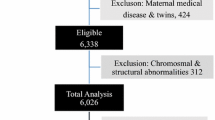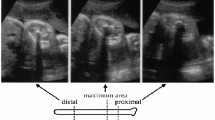Abstract
Objective
The aim of this study was to determine the effects of period of gestation and position of fetal neck on nuchal translucency measurement.
Materials and Methods
Nuchal translucency was measured in the mid-sagittal plane, with the fetal neck in the flexed, neutral, and extended positions in 100 pregnant women between 11 and 13+6 weeks. Mean nuchal translucency measurements at different periods of gestation were compared. Differences between the extended and neutral positions (Δ extended nuchal translucency) and those between the flexed and neutral positions (Δ flexed nuchal translucency) were calculated. The repeatability coefficients for the measurements in all the three positions were computed. Statistical analysis was also done.
Results
Nuchal translucency values were 1.050 ± 0.282 mm in the 11th week, 1.243 ± 0.348 mm in the 12th week, and 1.823 ± 0.357 mm in the 13th week (r = 0.747, p < 0.0001). The mean Δ flexed value was 0.233 ± 0.133 mm lesser than the neutral value (p < 0.0001). The mean Δ extended nuchal translucency was 0.305 ± 0.155 mm greater than the neutral value (p < 0.0001). The repeatability coefficient was the lowest in the neutral position (0.17 mm in the neutral position, 0.28 in the flexed position and 0.41 mm in the extended position).
Conclusion
We concluded that the period of gestation and fetal neck position can make a significant difference to nuchal translucency measurement. Repeatability of measurement is more accurate with the fetal neck in the neutral position. These findings have important implications for clinicians using nuchal translucency to screen the obstetric population for Down’s syndrome.




Similar content being viewed by others
References
Pandya PP, Kondylios A, Hilbert L, et al. Chromosomal defects and outcome in1015 fetuses with increased nuchal translucency. Ultrasound Obstet Gynecol. 1995;5:15–9.
Wheeler DM, Sinosich MJ. Prenatal screening in first trimester of pregnancy. Prenat Diagn. 1998;18:537–43.
de Graaf IM, Pajkrt E, Bilardo CM, et al. Early pregnancy screening for fetal aneuploidies with serum markers and nuchal translucency. Prenat Diagn. 1999;19:458–62.
Bland JM, Altman DG. Statistical methods for assessing agreement between two methods of clinical assessment. Lancet. 1986;i:307–10.
Braithwaite JM, Morris RW, Economides DJ. Nuchal translucency measurement: frequency distribution and changes with gestation in a general population. Br J Obstet Gynecol. 1996;103:1201–4.
Whitlow BJ, Chatzipapas IK, Economides DL. The effect of fetal neck position on nuchal translucency measurement. Br J Obstet Gynecol. 1998;105:872–6.
Braithwaite JM, Morris R, Economides DL. The measurement of nuchal translucency with transabdominal and transvaginal sonography: success rate, repeatability, and level of agreement. Br J Radiol. 1995;68:720–3.
Braithwaite JM, Kadir RA, Pepera T, et al. Nuchal translucency measurement: training of potential examiners. Ultrasound Obstet Gynecol. 1996;8:192–6.
We LK, Chai HY, Supriyanto E. Computerized nuchal translucency three dimensional reconstruction, visualization and measurement for trisomy 21 prenatal early assessment. Int J Phys Sci. 2011;6(19):4640–8.
Wee LK, Chai HY, Supriyanto E. Surface rendering of three dimensional ultrasound images using VTK. J Sci Ind Res. 2011;70(6):421–6.
Kagan KO, Wright D, Etchegaray A, et al. Effect of deviation of nuchal translucency measurements on the performance of screening for trisomy 21. Ultrasound Obstet Gynecol. 2009;33(6):657–64.
Del Carmen SM, DeVigan C, Vodovar V, et al. Measurement of nuchal translucency and the prenatal diagnosis of down syndrome. Obstet Gynecol. 2009;114(4):829–38.
Author information
Authors and Affiliations
Corresponding author
Electronic Supplementary Material
Below is the link to the electronic supplementary material.
Rights and permissions
About this article
Cite this article
Kore, S., Hegde, A., Kanavia, D. et al. Effects of Period of Gestation and Position of Fetal Neck on Nuchal Translucency Measurement. J Obstet Gynecol India 63, 244–248 (2013). https://doi.org/10.1007/s13224-012-0341-7
Received:
Accepted:
Published:
Issue Date:
DOI: https://doi.org/10.1007/s13224-012-0341-7




